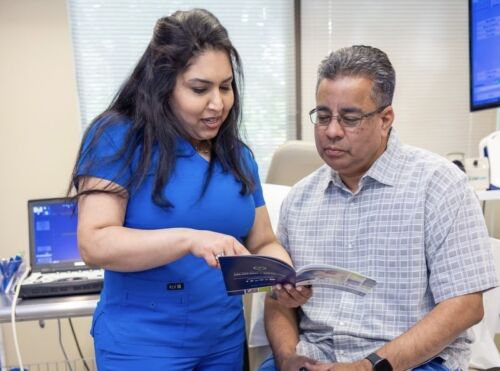Swollen ankles are not just uncomfortable and unsightly. They may also indicate a severe form of vein disease.
Swollen ankles can result from an injury. For example, an ankle can swell after a sprain. Your ankles may briefly swell if you sit or stand for too long. But if the swelling doesn’t go down, your swollen ankles may point to vein disease.
Swollen ankles are a red flag signaling that your veins aren’t transporting blood back to your heart. Your leg veins contain tiny valves that push blood upward. When these valves weaken, blood backflows and pools in the vein, causing what is medically known as chronic venous insufficiency (CVI). If left untreated, serious complications can arise, such as a blood clot in the leg. Fortunately, you can prevent these risks by treating vein disease when you first notice persistently swollen ankles.
What’s the connection between CVI and blood clots?
Blood clots can develop anywhere in the body. But they most often form in the legs and ankles as blood pools in the extremities. Venous pooling allows the blood cells to cluster and create a clot. As the clot blocks blood flow, fluid leaks into the surrounding tissue, causing the ankles and calves to swell.
But there are more worrying CVI complications than swelling, such as a deep vein thrombosis (DVT), a clot in the deep veins of the leg. Although DVT can be asymptomatic, common symptoms include significant swelling in one leg, pain, and warm, tender, reddish-looking skin. An ultrasound exam can detect a clot in the leg.
If you suspect you have DVT, seek immediate medical treatment. Clot-busting drugs can be prescribed to dissolve the clot before it breaks away and lodges in the lungs, causing a potentially life-threatening pulmonary embolism (PE). As the clot cuts off oxygen flow in the lungs, you’ll experience shortness of breath, chest pain, and a bloody cough. A PE will require treatment in the emergency room.
Blood clots tend to run in families. If you have a family history of clotting disorders, learn to identify the signs and seek preventative treatment.
How to reduce ankle swelling
As mentioned earlier, ankle swelling is just one sign of venous insufficiency. Twisting, protruding varicose veins also signal trouble with blood flow in the legs and ankles. Varicose veins are one of the most common symptoms of CVI.
Treating varicose veins can prevent blood clots from forming. Varicose vein treatment can also reduce the swelling, pain, and cramping of vein disease. Treatment can take two forms:
Conservative. The first line of treatment involves conservative methods. Wearing medical-grade compression stockings can boost circulation in the calves. Compression stockings are recommended if you sit all day on your job or are seated on a plane for more than four hours. You can also raise your legs above your heart to drain blood back to the heart and reduce ankle swelling. Exercise and losing weight can further reduce CVI symptoms and improve vein health.
Surgical. While conservative treatment can alleviate discomfort, surgery is the only way to eliminate varicose veins and free up blood flow. These minimally invasive procedures are performed in a brief office visit and destroy the diseased vein so blood can divert to healthier veins.
Don’t ignore ankle swelling!
Ankle swelling and varicose veins indicate a severe vascular disorder, so you should take your swollen ankles as a sign to seek vein disease treatment. The board-certified physicians at Center for Vein Restoration (CVR) are specially trained and experienced in treating all forms of chronic venous insufficiency.
Seek vein disease treatment early before complications such as blood clots develop. Most insurance, including Medicare and Medicaid, cover treatment. Contact one of our offices today for a consultation, or schedule online at your convenience.

 About Vein Disease
About Vein Disease
 Spider Veins
Spider Veins
 Varicose Veins
Varicose Veins
 Vein Disease Treatments
Vein Disease Treatments
 Treating Spider Veins
Treating Spider Veins
 Treating Varicose Veins
Treating Varicose Veins
 About Us
About Us
 Patient Resources
Patient Resources
 Physician Resources
Physician Resources


